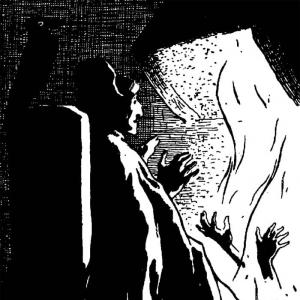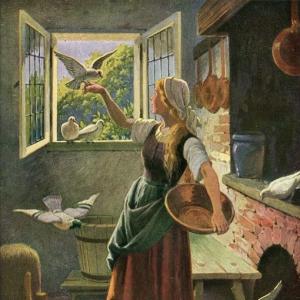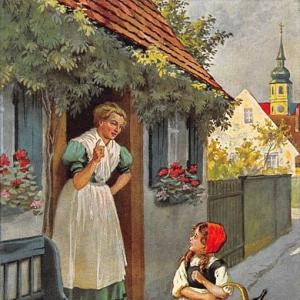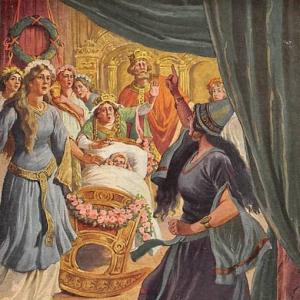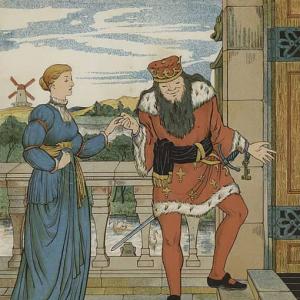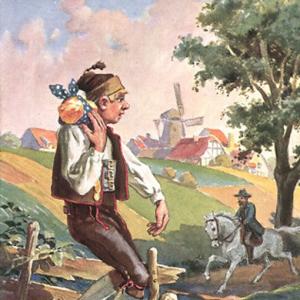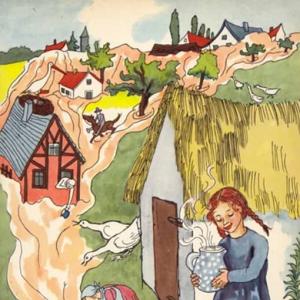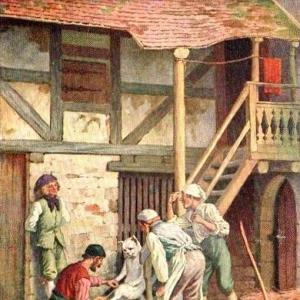Reading time: 4 min
There was once a poor woman who had a son, who much wished to travel, but his mother said, „How canst thou travel? We have no money at all for thee to take away with thee.“ Then said the son, „I will manage very well for myself. I will always say, ‚Not much, not much, not much.'“
So he walked for a long time and always said, „Not much, not much, not much.“ Then he passed by a company of fishermen and said, „God speed you! not much, not much, not much.“ – „What sayst thou churl, not much?“ And when the net was drawn out they had not caught much fish. So one of them fell on the youth with a stick and said, „Hast thou never seen me threshing?“ – „What ought I to say, then?“ asked the youth. „Thou must say, ‚Get it full, get it full.'“
After this he again walked a long time, and said, „Get it full, get it full,“ until he came to the gallows, where they had got a poor sinner whom they were about to hang. Then said he, „Good morning; get it full, get it full.“ – „What sayst thou, knave, get it full? Dost thou want to make out that there are still more wicked people in the world is not this enough?“ And he again got some blows on his back. „What am I to say, then?“ said he. „Thou must say, ‚May God have pity on the poor soul.'“
Again the youth walked on for a long while and said, „May God have pity on the poor soul!“ Then he came to a pit by which stood a knacker who was cutting up a horse. The youth said, „Good morning; God have pity on the poor soul!“ – „What dost thou say, thou ill-tempered knave?“ and the knacker gave him such a box on the ear, that he could not see out of his eyes. „What am I to say, then?“ – „Thou must say, ‚There lies the carrion in the pit!'“
So he walked on, and always said, „There lies the carrion in the pit, there lies the carrion in the pit.“ And he came to a cart full of people, so he said, „Good morning, there lies the carrion in the pit!“ Then the cart pushed him into a hole, and the driver took his whip and cracked it upon the youth, till he was forced to crawl back to his mother, and as long as he lived he never went out a-travelling again.
 Learn languages. Double-tap on a word.Learn languages in context with Childstories.org and Deepl.com.
Learn languages. Double-tap on a word.Learn languages in context with Childstories.org and Deepl.com.Backgrounds
Interpretations
Adaptions
Summary
Linguistics
„Going a-travelling“ is a lesser-known fairy tale collected by the Brothers Grimm, Jacob and Wilhelm, who were German academics, linguists, and cultural researchers. They are renowned for their collection of European fairy tales and folk stories, published as „Grimm’s Fairy Tales“ (also known as „Children’s and Household Tales“ or „Kinder- und Hausmärchen“ in German). The first edition of the collection was published in 1812, and it went through several editions and expansions during the brothers‘ lifetimes.
The Brothers Grimm collected these tales as part of their efforts to preserve and document the cultural heritage of Germany and Europe, at a time when industrialization and urbanization were threatening to erode traditional storytelling and folklore. They aimed to capture the oral traditions and local color of the stories, presenting them in a form that could be enjoyed by both children and adults.
„Going a-travelling“ is a narrative that offers moral lessons and cultural insight, as many other Grimm’s fairy tales do. Like other stories in the collection, it features relatable characters and situations, making it appealing to readers from diverse backgrounds. Despite its relatively obscure status compared to other Grimm’s tales, „Going a-travelling“ remains an interesting example of the Brothers Grimm’s efforts to document and share the richness of European folk culture.
„Going a-travelling“ is a cautionary tale that imparts several valuable lessons through the experiences of the protagonist. Here are some interpretations of the story.
The importance of context and communication: The protagonist’s encounters demonstrate that using the same expression in different contexts can lead to misunderstandings and unintended consequences. The story teaches the reader to be sensitive to the context of a situation and to communicate thoughtfully and appropriately.
Adapting to different situations: Throughout the tale, the youth learns to adapt his speech based on the various encounters he faces. This highlights the importance of being flexible and adjusting our behavior to suit different scenarios and people.
Learning from mistakes: The protagonist repeatedly faces negative consequences due to his choice of words. With each encounter, he learns a new expression that he believes is more appropriate. This illustrates the importance of learning from our mistakes and the value of personal growth.
Respecting others: The story emphasizes the need to treat others with respect and to be mindful of the impact that our words and actions can have on them. The youth’s inconsiderate comments result in misunderstandings and altercations, underscoring the importance of showing kindness and empathy toward others.
The dangers of naivety and inexperience: The protagonist’s misadventures reveal the potential pitfalls that can arise when venturing out into the world unprepared. His lack of experience and understanding lead to multiple setbacks, highlighting the importance of gaining knowledge and wisdom before embarking on new journeys.
Overall, „Going a-travelling“ is a moral tale that teaches readers about effective communication, empathy, adaptability, learning from mistakes, and the importance of experience and wisdom when facing new challenges.
The fairy tale „Going a-travelling“ (also known as „The Wishing Table, the Gold Ass, and the Cudgel in the Sack“) has been adapted into various forms over the years, including:
Children’s books: The story has been adapted into numerous children’s books, both as standalone tales and as part of collections of Grimm’s fairy tales. Some popular adaptations include „The Wishing Table and Other Stories“ by Clifton Johnson and „The Golden Ass: A Fairy Tale“ by Jenny Koralek.
Plays and operas: The story has also been adapted for the stage and opera. One notable adaptation is the children’s opera „The Wishing Table“ by Seymour Barab, which premiered in 1968.
Films and television: The story has been adapted into several films and television shows. One example is the 1954 German film „Das Wirtshaus im Spessart“ („The Spessart Inn“), which is loosely based on the fairy tale.
Video games: The story has even been adapted into video games, such as the 2015 game „The Wishing Table“ by indie developer KlickTock.
Overall, the enduring popularity of „Going a-travelling“ can be seen in the numerous adaptations and retellings of the story across various media over the years.
„Going a-travelling“ is a Brothers Grimm fairy tale that tells the story of a poor woman and her son, who is eager to travel despite their lack of money. The son sets off on his journey, deciding to manage by always saying, „Not much, not much, not much.“ He encounters various people and situations, learning different expressions that he should use depending on the context.
First, he comes across a group of fishermen and says, „Not much, not much, not much.“ Offended by his words, the fishermen chastise him, and he learns to say, „Get it full, get it full.“ Next, the youth encounters a man about to be hanged and mistakenly says, „Get it full, get it full.“ He is punished and learns to say, „May God have pity on the poor soul.“
The youth continues his journey, repeating the phrase he had just learned, until he meets a knacker cutting up a horse. The knacker, angered by the youth’s inappropriate words, strikes him and teaches him to say, „There lies the carrion in the pit!“ The youth then comes across a cart full of people and, using his new phrase, offends them as well. They push him into a hole and whip him until he crawls back to his mother.
The story concludes with the youth vowing never to go traveling again, having learned the importance of using appropriate expressions in different situations.
The Brothers Grimm fairy tale „Going a-Travelling“ offers an interesting exploration of linguistic pragmatics, semantics, and social norms through its narrative.
Pragmatics and Speech Acts: The protagonist’s journey reveals how context-specific language use governs social interactions. Each phrase he adopts is contextually inappropriate, leading to misunderstandings and negative repercussions. Speech acts, such as greetings or expressions of good wishes, have illocutionary forces—all about the speaker’s intent—and perlocutionary effects—how the listener interprets and reacts. The youth fails to grasp these, resulting in repeated miscommunications.
Semantics and Meaning: The phrases „Not much, not much,“ „Get it full, get it full,“ and „May God have pity on the poor soul“ all undergo semantic shifts when applied in different contexts. Each phrase holds different implications, which the protagonist does not comprehend. By misunderstanding the locutionary content (literal meaning) of his expressions, he generates unintended interpretations, emphasizing the complexity of meaning.
Social Norms and Etiquette: The tale highlights the role of cultural norms in guiding language use. The youth’s failure is partly due to his lack of understanding of social conventions guiding appropriate language in varying contexts (e. g. , fishing, execution scenes, encountering a pit). These norms dictate polite conduct and represent the unspoken rules in communication that the youth breaches.
Repetition and Formulaic Language: The protagonist’s reliance on formulaic phrases suggests rigid linguistic patterns often don’t translate effectively across contexts. His journey becomes a study in the importance of adaptable language use. The repetition of „Not much, not much“ and similar phrases reflects an oral storytelling tradition, serving as a memory aid and creating rhythmic structure.
Irony and Social Critique: The tale employs irony to critique the character’s naive belief in the sufficiency of simplistic language expressions without understanding context or intent. It further critiques social interactions that rely heavily on conventional phrases, questioning their meaning outside of accepted conventions.
Overall, „Going a-Travelling“ functions as a narrative about the importance of linguistic adaptability and awareness of social contexts. Through comedic missteps, it underscores how communication is not solely about the words spoken but their intended and perceived nuances within social frameworks.
Information for scientific analysis
Fairy tale statistics | Value |
|---|---|
| Readability Index by Björnsson | 16.2 |
| Flesch-Reading-Ease Index | 98.2 |
| Flesch–Kincaid Grade-Level | 2.6 |
| Gunning Fog Index | 5.6 |
| Coleman–Liau Index | 5.3 |
| SMOG Index | 5.8 |
| Automated Readability Index | 1.6 |
| Character Count | 2.121 |
| Letter Count | 1.543 |
| Sentence Count | 35 |
| Word Count | 430 |
| Average Words per Sentence | 12,29 |
| Words with more than 6 letters | 17 |
| Percentage of long words | 4% |
| Number of Syllables | 489 |
| Average Syllables per Word | 1,14 |
| Words with three Syllables | 7 |
| Percentage Words with three Syllables | 1.6% |

 Facebook
Facebook  Whatsapp
Whatsapp  Messenger
Messenger  Telegram
Telegram Reddit
Reddit